International Journal of Computer Network and Information Security @ijcnis
Статьи журнала - International Journal of Computer Network and Information Security
Все статьи: 1177
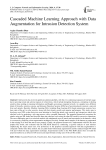
Cascaded Machine Learning Approach with Data Augmentation for Intrusion Detection System
Статья научная
Cybersecurity has received significant attention globally, with the ever-continuing expansion of internet usage, due to growing trends and adverse impacts of cybercrimes, which include disrupting businesses, corrupting or altering sensitive data, stealing or exposing information, and illegally accessing a computer network. As a popular way, different kinds of firewalls, antivirus systems, and Intrusion Detection Systems (IDS) have been introduced to protect a network from such attacks. Recently, Machine Learning (ML), including Deep Learning (DL) based autonomous systems, have been state-of-the-art in cyber security, along with their drastic growth and superior performance. This study aims to develop a novel IDS system that gives more attention to classifying attack cases correctly and categorizes attacks into subclass levels by proposing a two-step process with a cascaded framework. The proposed framework recognizes the attacks using one ML model and classifies them into subclass levels using the other ML model in successive operations. The most challenging part is to train both models with unbalanced cases of attacks and non-attacks in the datasets, which is overcome by proposing a data augmentation technique. Precisely, limited attack samples of the dataset are augmented in the training set to learn the attack cases properly. Finally, the proposed framework is implemented with NN, the most popular ML model, and evaluated with the NSL-KDD dataset by conducting a rigorous analysis of each subclass emphasizing the major attack class. The proficiency of the proposed cascaded approach with data augmentation is compared with the other three models: the cascaded model without data augmentation and the standard single NN model with and without the data augmentation technique. Experimental results on the NSL-KDD dataset have revealed the proposed method as an effective IDS system and outperformed existing state-of-the-art ML models.
Бесплатно
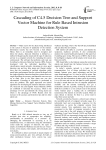
Cascading of C4.5 Decision Tree and Support Vector Machine for Rule Based Intrusion Detection System
Статья научная
Main reason for the attack being introduced to the system is because of popularity of the internet. Information security has now become a vital subject. Hence, there is an immediate need to recognize and detect the attacks. Intrusion Detection is defined as a method of diagnosing the attack and the sign of malicious activity in a computer network by evaluating the system continuously. The software that performs such task can be defined as Intrusion Detection Systems (IDS). System developed with the individual algorithms like classification, neural networks, clustering etc. gives good detection rate and less false alarm rate. Recent studies show that the cascading of multiple algorithm yields much better performance than the system developed with the single algorithm. Intrusion detection systems that uses single algorithm, the accuracy and detection rate were not up to mark. Rise in the false alarm rate was also encountered. Cascading of algorithm is performed to solve this problem. This paper represents two hybrid algorithms for developing the intrusion detection system. C4.5 decision tree and Support Vector Machine (SVM) are combined to maximize the accuracy, which is the advantage of C4.5 and diminish the wrong alarm rate which is the advantage of SVM. Results show the increase in the accuracy and detection rate and less false alarm rate.
Бесплатно
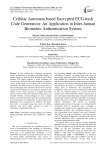
Статья научная
In this modern era, biometrics incorporate various mechanisms to recognize inimitable features of human beings by utilizing their biological and evident features. This paper proposes a novel technique for constructing a resilient and secure biometric recognition system. In this paper, an ECG-hash code of two distinct individuals has been formed by taking dot product of electrocardiogram (ECG) feature matrices of two persons located at two different sites at respective databases. The validity of the system increases as samples from both persons, between whom the transmission takes place, are essential. Besides, electrocardiogram is such a unique feature of an individual that could not be compromised at any circumstance as contradictory to other features like fingerprints, face recognition etc. Moreover, the ECG-hash code is encrypted using rule vector of cellular automata that gives better security in terms of randomness of generated cipher text.
Бесплатно
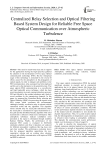
Статья научная
The need for much better data rate in support for the applications having the high speed has gathered the attention to the development of Free space Optical communication technology (FSO). But the widespread usage of this technology is restrained by the several ill effects caused by the atmosphere on the propagation of optical signals. In order to mitigate such problems in the FSO communication, relay assistance has been employed and this serves the alternative to the spatial diversity. Free space optical (FSO) communication is a cost-effective and high bandwidth access technique, which has been receiving attention to recent commercialization successes. FSO get affected by the weather turbulence and it leads to severe problems in the transmission channels. In this paper, we proposed the Centralized Relay selection and Optical Filtering (CROF) for processing the signals in the FSO system which overcomes the environmental challenges. Initially, an effective relay is selected with the centralized switch and stay algorithm. This algorithm selects suitable relay for serial path transmission. Here, the serial path is considered for signal transmission in a free path and the distributed Greedy algorithm with serial transmission is utilized to obtain more information. Then atmospheric turbulence induced scintillation noise presented at the signal is eliminated through modified Kalman filtering. Finally, the performance of the proposed FSO system is evaluated in MATLAB simulation platform and these evaluations are analyzed for different atmospheric conditions like fog, haze, rain and clear weather. The performance evaluation shows that the proposed algorithm outperforms the non-cooperative scheme and an existing relay selection protocol and reliable communication with improved SNR and BER is achieved.
Бесплатно
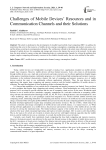
Challenges of Mobile Devices' Resources and in Communication Channels and their Solutions
Статья научная
The article is dedicated to the development of cloudlet based mobile cloud computing (MCC) to address the restrictions that occur in the resources of mobile devices (energy consumption, computing and memory resources, etc.) and the delays occurring in communication channels. The architecture offered in the article more efficiently ensures the demand of mobile devices for computing and storage and removes the latency that occur in the network. At the same time, the tasks related to energy saving and eliminating delays in communication channels by solving the problems that require complex computing and memory resources in the cloudlets located nearby the user were outlined in the article.
Бесплатно
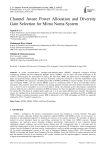
Channel Aware Power Allocation and Diversity Gain Selection for Mimo Noma System
Статья научная
In recent communications, multiple-input-multiple-output (MIMO), orthogonal frequency division multiplexing (OFDM) and Non-Orthogonal Multiple Access (NOMA), and are major sub-system techniques of 5G wireless communications for optimization of latency, Bit Error Rate (BER) and improvement of throughput. In this paper, the proposed design, manages the resource allocations among the techniques to meet the requirements using NOMA and MIMO. The interactive waterfilling based PA in MIMO and NOMA to improve Quality of Service (QoS) and investigated NOMA cell free massive MIMO system by considering effect of linear and individual channel estimations. The proposed system also optimizes user pairing approach for group users that optimize downlink rate per user so that PA can be acceptable at cost of involvedness. Lastly, the proposed system demonstrates experimental results to different noisy channel to minimize the BER and latency that does not degraded in performance compared to the existing PA. The design is validated under single user, 2, 4, 8 users under different noisy channels. The proposed system also validated for up-link transmission under same channels by interactive waterfilling based PA in MIMO and NOMA. Based on obtained simulation results, BER is optimized by 8%, SNR, throughput and PAPR are optimally obtained by 5.5%, 7% and 6% respectively.
Бесплатно
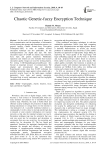
Chaotic Genetic-fuzzy encryption technique
Статья научная
As the result of increasing use of internet in daily communication and the importance of information security during data storage and transmission process, we propose iterative Chaotic Genetic-fuzzy Encryption Technique(C-GET) in order to enhance secured encryption technique and less predictable. In this technique,binarize any digital data type. The main encryption stages of C-GET are chaotic map functions, fuzzy logic and genetic operations. Mathematic operations and rotation are also included that increase encryption quality. Images are used for testing propose. For testing C-GET,digitalimagesareusedbecause they become an important resource of communication. The original and reconstructed data are identical. Experimental results show that C-GET technique has multilayer protection stages against various attacks and a powerful security based on the multi-stages, multiple parameters, fuzzy logic and genetic operations. Decrypted data is nearly randomness and has negligible correlation with secret data.
Бесплатно
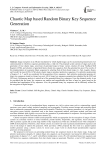
Chaotic Map based Random Binary Key Sequence Generation
Статья научная
Image encryption is an efficient mechanism by which digital images can be secured during transmission over communication in which key sequence generation plays a vital role. The proposed system consists of stages such as the generation of four chaotic maps, conversion of generated maps to binary vectors, rotation of Linear Feedback Shift Register (LFSR), and selection of generated binary chaotic key sequences from the generated key pool. The novelty of this implementation is to generate binary sequences by selecting from all four chaotic maps viz., Tent, Logistic, Henon, and Arnold Cat map (ACM). LFSR selects chaotic maps to produce random key sequences. Five primitive polynomials of degrees 5, 6, 7, and 8 are considered for the generation of key sequences. Each primitive polynomial generates 61 binary key sequences stored in a binary key pool. All 61 binary key sequences generated are submitted for the NIST and FIPS tests. Performance analysis is carried out of the generated binary key sequences. From the obtained results, it can be concluded that the binary key sequences are random and unpredictable and have a large key space based on the individual and combination of key sequences. Also, the generated binary key sequences can be efficiently utilized for the encryption of digital images.
Бесплатно
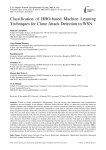
Classification of HHO-based Machine Learning Techniques for Clone Attack Detection in WSN
Статья научная
Thanks to recent technological advancements, low-cost sensors with dispensation and communication capabilities are now feasible. As an example, a Wireless Sensor Network (WSN) is a network in which the nodes are mobile computers that exchange data with one another over wireless connections rather than relying on a central server. These inexpensive sensor nodes are particularly vulnerable to a clone node or replication assault because of their limited processing power, memory, battery life, and absence of tamper-resistant hardware. Once an attacker compromises a sensor node, they can create many copies of it elsewhere in the network that share the same ID. This would give the attacker complete internal control of the network, allowing them to mimic the genuine nodes' behavior. This is why scientists are so intent on developing better clone assault detection procedures. This research proposes a machine learning based clone node detection (ML-CND) technique to identify clone nodes in wireless networks. The goal is to identify clones effectively enough to prevent cloning attacks from happening in the first place. Use a low-cost identity verification process to identify clones in specific locations as well as around the globe. Using the Optimized Extreme Learning Machine (OELM), with kernels of ELM ideally determined through the Horse Herd Metaheuristic Optimization Algorithm (HHO), this technique safeguards the network from node identity replicas. Using the node identity replicas, the most reliable transmission path may be selected. The procedure is meant to be used to retrieve data from a network node. The simulation result demonstrates the performance analysis of several factors, including sensitivity, specificity, recall, and detection.
Бесплатно

Classification via Clustering for Anonymization Data
Статья научная
Due to the exponential growth of hardware technology particularly in the field of electronic data storage media and processing such data, has raised serious issues related in order to protect the individual privacy like ethical, philosophical and legal. Data mining techniques are employed to ensure the privacy. Privacy Preserving Data Mining (PPDM) techniques aim at protecting the sensitive data and mining results. In this study, the different Clustering techniques via classification with and without anonymization data using mining tool WEKA is presented. The aim of this study is to investigate the performance of different clustering methods for the diabetic data set and to compare the efficiency of privacy preserving mining. The accuracy of classification via clustering is evaluated using K-means, Expectation-Maximization (EM) and Density based clustering methods.
Бесплатно
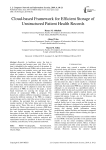
Cloud-based framework for efficient storage of unstructured patient health records
Статья научная
Recently, in healthcare sector, the data is steadily growing and becomes more vital. Most of this data is embedded in the medical record of the patient. In fact, Patient Health Records (PHRs) refer to those records that the patient can maintain, access and share among different specialists. Storing these PHRs to the cloud allow the patient to maintain and share them with different practitioners anywhere and anytime. However, he still suffers from some security and privacy issues. Hence, it is necessary to guarantee the security and privacy of this immense volume of patient's confidential data on the cloud. Anonymization and encryption are the two methods that can be adopted to ensure the security and privacy of PHRs on cloud. In this paper, a cloud-based framework for securing the storage and the retrieval of unstructured PHRs is proposed. This framework combines different encryption techniques to encrypt the different contents of the PHR, to compress medical images and to control the access to these records. In addition, the encrypted files are partitioned into a random number of files before being sent to the cloud storage server. These files are of variable number and variable size. When a user requests to access a PHR from the cloud, the proposed framework first controls access of this user before merging the partitioned files. The decryption of these files is performed on the client side not on the cloud using the secret key, which is owned by authorized user only. Finally, extensive analytical and experimental results are presented. It shows the security, scalability, and efficiency of the proposed framework.
Бесплатно
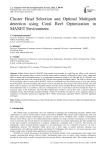
Статья научная
Mobile Ad-hoc Network (MANET) data transfer between nodes in a multi-hop way offers a wide variety of applications. The dynamic feature of ad hoc network mobile nodes is primarily influenced by safety issues, which limit data forwarding rate in multipath routing. As a supplementary method to improve safe data delivery in a MANET, this paper propose and analyse the cluster head (CH) selection and optimum multipath scheme. The CHs are chosen based on the possibility values of each node in MANET, which are considered from the residual energy of each node. During the present phase, the total remaining node energy is used to calculate the mean energy of the entire network. The most likely nodes are picked as the CH, which gathers packets from the cluster members through multi-hop communication. The fundamental idea is to partition a top-secret communication into several shares and then forward the shares via numerous routes to the destination. The Coral Reef Optimization method is used in this work to perform optimum multipath routing. The thorough simulation findings validate the feasibility and efficacy of the suggested strategy in comparison to Butterfly optimization algorithm (BA), Whale Optimization algorithm (WOA) and BAT algorithm techniques.
Бесплатно
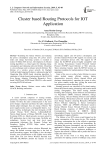
Cluster based routing protocols for IOT application
Статья научная
Extending the battery lifetime and reducing the power consumption using ultra low power sensor nodes and energy harvesting systems is essential to realize 50 billion IOT devices. Development of efficient routing algorithm is a critical aspect for reducing energy consumption and enhancing network lifetime. Clustering is a key technique used to enhance network lifetime. The lifetime of a wireless sensor network for Daylight Artificial Light Integrated Scheme is enhanced using Self Organizing Map (SOM) based clustering algorithm. A simulation of cluster based routing protocols like LEACH (Low Energy Adaptive Clustering Hierarchy), Fuzzy based LEACH and ANFIS based LEACH is also carried out using MATLAB software.
Бесплатно
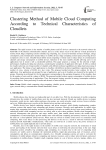
Clustering Method of Mobile Cloud Computing According to Technical Characteristics of Cloudlets
Статья научная
The rapid increase in the number of mobile phones and IoT devices connected to the network reduces the bandwidth of the Internet communication channel, and as a result, delays occur in the delivery of data processed in remote clouds. Edge computing systems (cloudlet, fog computing, etc.) are used to eliminate resource shortages, energy consumption, and communication channel delays in mobile devices. Edge computing systems place processing devices (computers) close to users. Cloudlet-based mobile cloud computing is widely used to reduce delays in communication channels and energy consumption in mobile devices. Selection of the most suitable cloudlet allowing users to run applications fast in cloud is still a considerable problem. This paper proposes a strategy for the selection of high-performance cloudlets providing fast solutions, considering the complexity of application (file type). It offers a method for cloudlet selection out of large number of cloudlets with different technical capabilities providing faster processing of user application. The timing of user applications in cloudlets with different technical capabilities (operating frequency, number of cores, volume of RAM, etc.) also varies. The proposed method provides faster solution for the user application. User applications are grouped by type of application, and a set of cloudlets are clustered by the number of groups. Clustering is performed first by the parameters corresponding to the operating frequency of the cloudlets, then by the number of cores and the volume of RAM. The proposed method reduces energy consumption of mobile devices by providing faster processing of applications. Thus, the proposed strategy provides an energy consumption reduction on mobile devices, faster processing of results and decrease of network delays.
Бесплатно
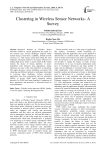
Clustering in Wireless Sensor Networks- A Survey
Статья научная
Increased demand of Wireless Sensor Networks (WSN) in various applications has made it a hot research area. Several challenges imposed which include energy conservation, scalability, limited network resources etc. with energy conservation being the most important. Clustering improves the energy efficiency by making high power nodes as cluster heads (CHs) which reduces the chance of energy depletion of nodes. Scalability, fault tolerance, data aggregation, energy efficiency are some of the main objectives of clustering. This paper discusses various challenges associated with clustering and different methods or techniques developed to overcome these challenges. Various clustering approaches have been summarized and few prominent Quality of service (QoS) based clustering routing protocols for WSN have been identified. Comparison of these approaches and protocols is discussed based on some parameters.
Бесплатно
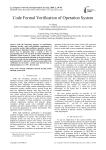
Code Formal Verification of Operation System
Статья научная
With the increasing pressure on non-function attributes (security, safety and reliability) requirements of an operation system, high–confidence operation system is becoming more important. Formal verification is the only known way to guarantee that a system is free of programming errors. We research on formal verification of operation system kernel in system code level and take theorem proving and model checking as the main technical methods to resolve the key techniques of verifying operation system kernel in C code level. We present a case study to the verification of real-world C systems code derived from an implementation of μC/OS – II in the end.
Бесплатно
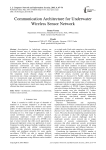
Communication Architecture for Underwater Wireless Sensor Network
Статья научная
Investigations in hydrologic sciences are bounded because most of existing water surveillance methods are manual. Such systems are incapable to gather information at spatial and temporal level due to location constraints. In this paper, we present a new communication architecture for Underwater Wireless Sensor Network (UWSN) based on acoustic communication. However, unique challenges offered by underwater environment are main hindrance in deployment of UWSN in real life applications. So, we discuss various communication methodologies to figure out which one suits best to the requirements of UWSN. Our simulation results illustrate change in data transmission rate, energy consumption and transmission time w.r.t transmission range and number of nodes in network. Results prove that multi-hop communication offer high transmission rate, large bandwidth. Moreover, multi-hop communication is much more energy and time efficient than direct communication.
Бесплатно
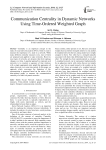
Communication Centrality in Dynamic Networks Using Time-Ordered Weighted Graph
Статья научная
Centrality is an important concept in the study of social network analysis (SNA), which is used to measure the importance of a node in a network. While many different centrality measures exist, most of them are proposed and applied to static networks. However, most types of networks are dynamic that their topology changes over time. A popular approach to represent such networks is to construct a sequence of time windows with a single aggregated static graph that aggregates all edges observed over some time period. In this paper, an approach which overcomes the limitation of this representation is proposed based on the notion of the time-ordered graph, to measure the communication centrality of a node in dynamic networks.
Бесплатно
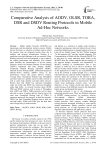
Comparative Analysis of AODV, OLSR, TORA, DSR and DSDV Routing Protocols in Mobile Ad-Hoc Networks
Статья научная
Mobile Ad-Hoc Networks (MANETs) are autonomous and decentralized wireless systems. Mobile Ad hoc Network is a collection of mobile nodes in which the wireless links are frequently broken down due to mobility and dynamic infrastructure. Routing is a significant issue and challenge in ad hoc networks. Many Routing protocols have been proposed so far to improve the routing performance and reliability. This research paper describes the characteristics of ad hoc routing protocols Ad-hoc On Demand Distance Vector Routing (AODV), Optimized link State Routing (OLSR), Temporally Ordered Routing Algorithm (TORA), Dynamic Source Routing (DSR), Destination-Sequenced Distance-Vector Routing (DSDV) based on the performance metrics like packet delivery fraction, Average delay, Normalized Routing load, Throughput and Jitter under low mobility and low traffic network as well as under high mobility and high traffic network. Results show that AODV has maximum throughput under low traffic and DSDV has maximum throughput under high traffic. As network becomes dense OLSR, DSR and DSDV perform well in terms of Throughput than AODV and TORA. TORA performs well in dense networks in terms of packet delivery fraction but at the same time Normalized Routing load of TORA is maximum among all the protocols in both the networks. DSDV has least Normalized Routing load in both low and high traffic. OLSR and DSDV give the least Jitter and Average Delay in both networks.
Бесплатно

Comparative Analysis of Classification Algorithms on KDD'99 Data Set
Статья научная
Due to the enormous growth of network based services and the need for secure communications over the network there is an increasing emphasis on improving intrusion detection systems so as to detect the growing network attacks. A lot of data mining techniques have been proposed to detect intrusions in the network. In this paper study of two different classification algorithms has been carried out: Naïve Bayes and J48. Results obtained after applying these algorithms on 10% of the KDD'99 dataset and on 10% of the filtered KDD'99 dataset are compared and analyzed based on several performance metrics. Comparison between these two algorithms is also done on the basis of the percentage of correctly classified instances of different attack categories present in both the datasets as well as the time they take to build their classification models.Overall J48 is a better classifier compared to Naïve Bayes on both the datasets but it is slow in building the classification model.
Бесплатно

